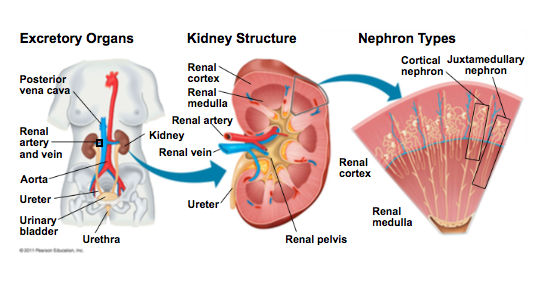Chapter 44 Learning Objectives
1/20
There's no tags or description
Looks like no tags are added yet.
Name | Mastery | Learn | Test | Matching | Spaced |
|---|
No study sessions yet.
21 Terms
What is meant by the term osmoregulation?
controls solute concentrations and balances water gain and loss
What is the function of excretion?
ridding the body of nitrogenous metabolites and other metabolic waste products
What are contractile vacuoles, protonephridia, metanephridia, and Malphigian tubules? Which groups have them?
Contractile Vacuoles: prevents the cell from absorbing too much water and possibly rupturing through excessive internal pressure. Expels water out of cell by contracting. Mostly in unicellular organisms
Protonephridia: network of dead-end tubules that branch throughout the body. Excrete a dilute fluid and function in osmoregulation. In non-parasitic flatworms.
Metanephridia: consists of tubules that collect coelomic fluid and produce dilute urine for excretion. In earthworm.
Malphigian Tubules: remove nitrogenous wastes from hemolymph. Waste and K+ are secreted into tubules by active transport. Which creates an osmotic gradient that draws water into tubules by osmosis. In insects and other terrestrial arthropods.
Compare and contrast osmoconformer and osmoregulator.
Osmoconformer: organisms that are in osmotic equilibrium with their environment.
Osmoregulators: organisms that maintain a constant blood osmolarity despite different concentrations in their external environment.
Compare and contrast how marine animals and freshwater animals balance water and salt between their bodies and their environment. Should be familiar with strategies used by hagfish, sharks, bony fishes, and air-breathing marine animals
Hagfish: osmoconfomers with ionic balance similar to external environment. Water exchange is minimal. Net influx of other ions is eliminated in slime and in a weak kidney. Do have elevated Na+ possibly from diet
Sharks: retain urea to elevate total solutes. Produce urine to eliminate excess water. Have TMAO to prevent urea from denaturing enzymes. Most salts are eliminated in kidneys. Have a rectal gland that can actively transport salts into gut.
Bony Fishes: loses a lot of water and take in a lot of salts. Water is replaced by drinking which increases salt load. Salts are eliminated by chloride cells in gill tissue that use active transport. Significant use of metabolic energy.
Non-Fish Marine Vertebrate: some excess salt is taken in largely from the diet and water swallowed with food. Mammals eliminate salts almost entirely in the kidneys. Bird and reptile kidneys are usually not as efficient so they also have an extra renal gland.
Freshwater Animals: constantly take in water by osmosis and lose salts to their hypoosmotic environment.
List some adaptations that land animals have to reduce water loss.
urinary/osmoregulatory systems have evolved in terrestrial vertebrates that help them retain water. Various adaptations in skin and respiratory systems also reduce water loss.
What type of waste products do the breakdown of proteins and nucleic acids produce? In which chemical forms are these waste products excreted?
Ammonia is the waste produced by metabolism of nitrogen-containing compounds like proteins and nucleic acids.
Excreted through the urine or returned to the systemic circulation though the renal veins.
Describe the relationship between the four key components of most excretory systems (filtration, filtrate, reabsorption, secretion).
Filtration: also known as glomerular filtration, is the first step in the process of urine formation. The kidneys filter blood through a process called glomerular filtration, which separates plasma from blood cells. Filtering of body fluids.
Filtrate: is the result of glomerular filtration which contains waste but also other substances the body needs.
Reabsorption: recovering valuable solutes. Also known as tubular reabsorption, is the process by which the nephrons in the kidneys remove water and solutes from the tubular fluid and return them to the circulatory system
Secretion: adding nonessential solutes and wastes to the filtrate. Process of moving molecules from the blood to urine. The secreted ions combine with the remaining filtrate to become urine, which then flows out of the nephron tubule into a collecting duct
What are the excretory organs of vertebrates?
kidneys, ureters, urinary bladder, urethra
Diagram the Mammalian excretory System and explain what happens at each phase of filtration. (see figure 44.12)

List some examples of how active and passive transport is used in the nephron and collecting ducts of the kidney
Passive and active transport are used in the kidney to convert filtrate into urine. Passive transport moves water along osmotic gradients created by salt transfer, while active transport moves sodium salts
Osmoregulation
controls solute concentrations and balances water gain and loss
Excretion
processed filtrate containing nitrogenous wastes is released from the body
Osmolarity
refers to the number of particles or the concentration of a particular solute or solutes per liter of solvent
Hypoosmotic/Hyperosmotic
Hypoosmotic: solution with lower osmolarity
Hyperosmotic: solution with higher osmolarity
Ammonia
is waste product of the body which is excreted
Urea
is a nitrogen-containing waste substance that the kidneys clear from the blood and excrete into the urine
Uric Acid
a waste product that the body produces when it breaks down purines.
insects, land snails and many reptiles including birds mainly excrete uric acid
is even more energetically expensive to produce than urea
Kidneys
is a structure in the body that removes waste products from the blood and produce urine
Medulla
the inner part of the kidney. Regulates concentration of the urine
Cortex
outside layer of the kidney. Where the nephrons (blood filtering units) begin